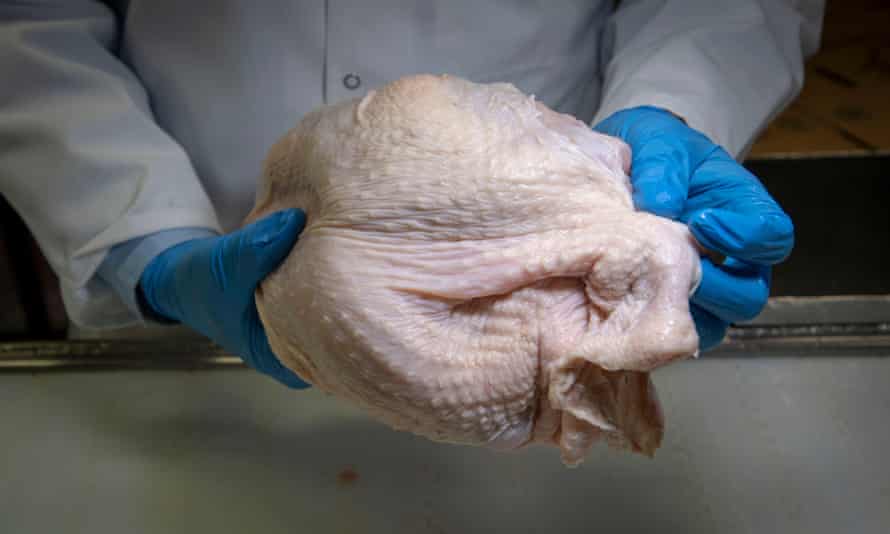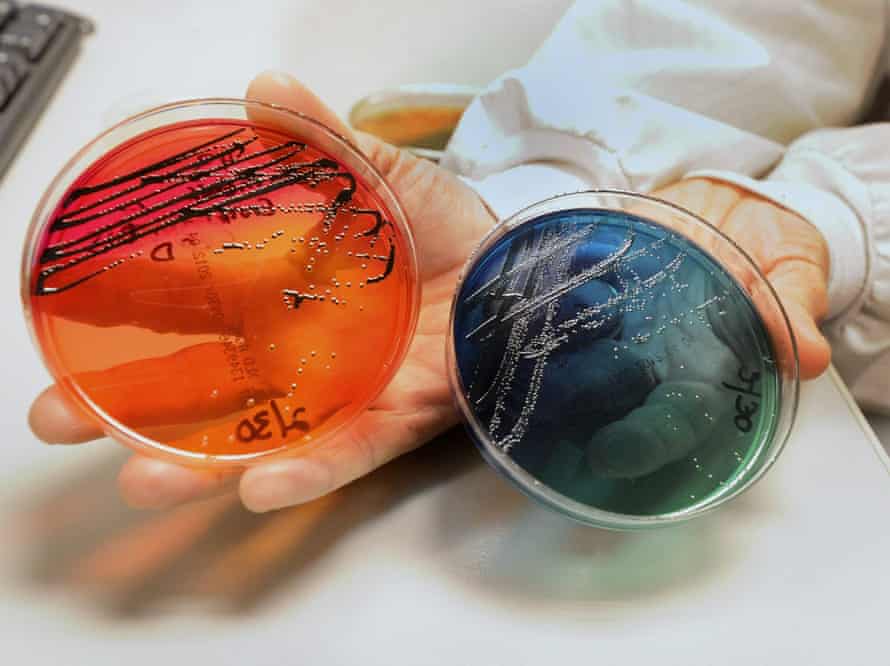Why salmonella is a food poisoning killer that won’t go away in the US
About 1.35m Americans a year fall ill from the bacteria. Why are there still so many infections?

Last modified on Tue 10 Aug 2021 10.06 EDT
In my kitchen, I treat raw chicken as if it’s crawling with bacteria that could make me and my family sick. I use separate cutting boards for meats and produce; I wash my hands and disinfect everything that comes close to the bird, then cook it to 74C (165F). A little paranoid, but with good reason.
Chickens, turkeys and other fowl commonly harbour salmonella bacteria that are harmless to the birds but not to humans.
US Department of Agriculture (USDA) regulations aim to curtail – but not eliminate – the bacteria. Under the current “performance standards”, for example, up to 15.4% of chicken parts leaving a processing plant are permitted to test positive for salmonella. Contamination exceeds those levels in about one in 10 plants, according to a report in July by the USDA’s Food Safety and Inspection Service (FSIS).
If restaurants, food-processing facilities and home chefs like me are scrupulously careful in handling poultry, we can avoid ingesting the bacteria. But it’s easy to slip up. Salmonella is the second leading cause of food poisoning in the US, making an estimated 1.35 million Americans sick annually, and leading to about 26,500 hospitalisations and 420 deaths, according to the Centers for Disease Control and Prevention (CDC), the US public health agency.
Chicken and turkey are responsible for about a fifth of infections – more than any other food category.
Poultry companies have invested tens of millions of dollars in enhancing the safety of products, says Ashley Peterson, senior vice-president of regulatory affairs at the National Chicken Council. As a result, she says, the prevalence of salmonella on chicken is at an all-time low.
Despite those efforts, though, the infection rate remains stubbornly high. A 2020 CDC report said: “The incidence of most infections transmitted commonly through food has not declined for many years.” It found that the incidence of illnesses, hospitalisations and deaths due to salmonella rose by 5% in 2019 compared with the previous three years.
Martin Wiedmann, professor of food safety at Cornell University, said: “We are winning at a numbers game with regards to the percentage of chickens positive for salmonella, but losing the public health game.”
Tackling salmonella earlier
Current regulations for salmonella in poultry are “antiquated”, says Brian Ronholm, director of food policy for the US non-profit organisation Consumer Reports, who has called for stronger enforceable standards over the salmonella strains that pose the greatest public health risk.
The current system treats all salmonella equally, even though most human illness is caused by only a handful of more than 2,500 identified strains. The most common strain found in poultry, S kentucky, rarely makes people sick.
Last January, Consumer Reports joined other consumer advocacy organisations and a group of people affected by salmonella infections to petition the USDA to overhaul food safety standards.
“If we can set up a system that puts greater value on monitoring and controlling the highest risks, I think that’s how you get to a meaningful pathway to reducing salmonella illnesses,” says Ronholm.
Over the years, advocacy groups have petitioned the USDA, without success, to enact a zero-tolerance policy for certain types of salmonella in poultry. The department’s reluctance probably stems from the loss of a court case against the Texas-based meat-processing company Supreme Beef in 2001. A federal court ruled that the USDA could not shut down a plant for failing to meet salmonella standards because the bacteria occur naturally in animals and can be destroyed by proper cooking.
The most recent petition focuses on what is, perhaps, a more realistic goal: not eliminating virulent strains but at least setting limits on them. Today, a processor could meet USDA standards by reducing S kentucky and still not prevent a single case of food poisoning, says Wiedmann.
“The public will be much better off if I keep S kentucky where it is and knock down [Salmonella] typhimurium, enteritidis, and newport,” he says, listing the three strains responsible for about 40% of the disease in humans.
The petitioners’ other big objective is for the USDA to make chicken processing companies responsible for their supply chain. “The current system tests the product at the end of the line, before it’s shipped out the door,” says Sarah Sorscher, deputy director of regulatory affairs at the Washington-based Center for Science in the Public Interest. “That type of test really incentivises chemical washes as the main way to deal with contamination in the meat.”

Chemical washes do not kill all bacteria, however. “If you want to eliminate the worst types of salmonella, you really do have to start at the farm because that’s where the pathogens are spreading between animals,” says Sorscher. That might involve vaccinating poultry and regularly testing flocks to control a worrisome strain before it spreads, she adds.
Reducing nastier strains of salmonella before poultry reaches the slaughterhouse has been proven to work. After more than 600 people fell ill with S Heidelberg linked to Foster Farms chicken in 2013 and 2014, the company spent $70m (GBP43m then) on programmes to control the bacteria. Efforts included encouraging farmers to increase vaccinations, and requiring chicks from breeding flocks to be free of Heidelberg.
Heidelberg, once one of the most common causes of salmonella infections, no longer ranks in the top 20 now, according to the CDC.
Wariness in the meat industry
In response to the petition, two large trade organisations – the North American Meat Institute and the National Chicken Council – agreed on setting limits for the overall amount of salmonella in a product, but not on targeting specific strains. The USDA treats all levels of contamination the same, even though undercooked chicken containing a lot of salmonella is more likely to make you sick than a piece with just a trace.
In general, the industry’s view is that the science has not advanced enough to identify which strains to target. Bacteria evolve and genetic information passes between strains, so a harmless variant could become more virulent over time. It can take 10 years for the USDA to approve a new poultry vaccine and by that time another strain may prove to be a bigger threat.
Furthermore, the trade organisations claim, the FSIS has no jurisdiction over farms and cannot legally compel processors to take responsibility for how poultry growers raise their birds.
Finding a solution that reflects the public health science, but that is also workable – given the realities and practicalities of poultry production – is going to be a long process, says Mike Taylor, former head of the FSIS and currently a board member for the advocacy group Stop Foodborne Illness.
However, change may be afoot. Sandra Eskin, the USDA’s deputy undersecretary of food safety, has said finding feasible ways of reducing illness from salmonella in poultry is a priority.
In the meantime, I’ll still be handling raw chicken and turkey as if it’s hazardous material. “No regulation or law will ever make it sterile,” says Peterson. “Proper handling and cooking is the one thing that will eliminate any risk of foodborne illness.”
Sign up for the Animals farmed monthly update to get a roundup of the best farming and food stories across the world and keep up with our investigations. You can send us your stories and thoughts at animalsfarmed@theguardian.com
